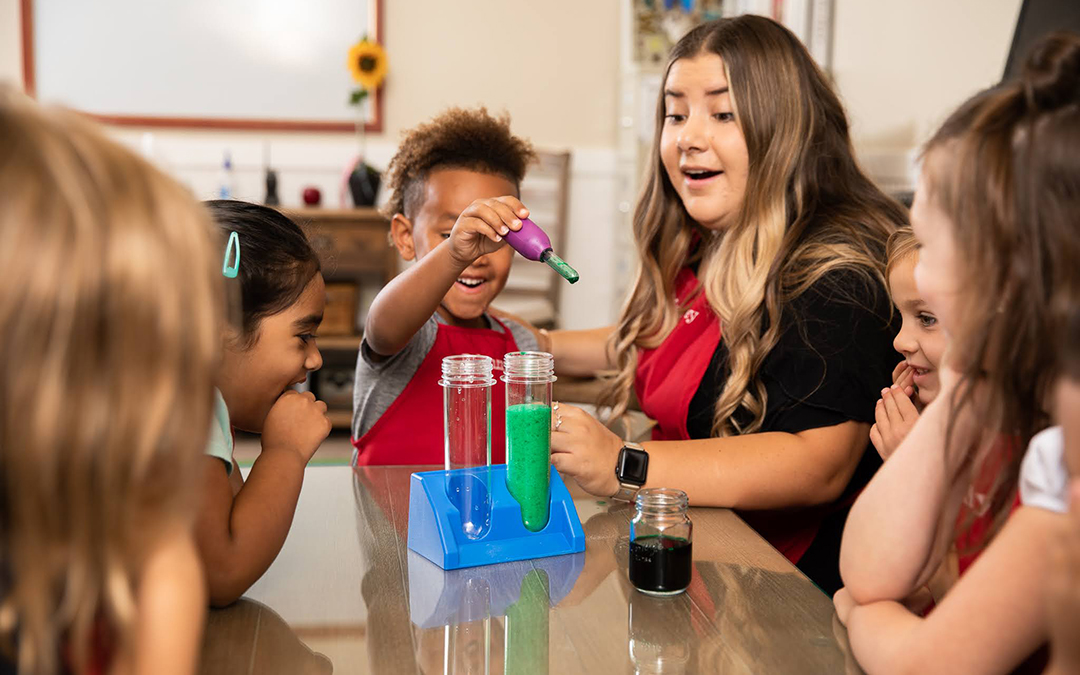Six Toddler-Friendly Science Experiments
Cultivating your toddler’s interest in science may seem a bit overwhelming. They don’t have a lengthy attention span. Their limited interactions mean that there’s not much foundational knowledge from which to build, but that also means the sky’s the limit!
Everyone knows kids like asking, “why?”. Well, it’s time to find out!
Teaching Young Tots
With all of these, make sure your kids are supervised at all times.
Sink or Float?
Supplies: sink or tub, water, household objects
Grab random household objects and get them to guess whether they will “sink” or “float”! Introduce them to density and, as a bonus, the scientific method: by guessing whether the item will “sink” or “float”, they’ll have made a hypothesis followed by a test to get a measurable result!
Ideas for items: old bottles of soap or lotion, kitchen utensils, and any toys you don’t mind getting wet.
Magic Milk
Supplies: milk, water, dish soap, food coloring
Simply add a thin layer of milk to a pan, then add drops of food coloring. Dip a cotton swab in some dish soap, then dip into the milk and solution and hold it for about 15 seconds.
How Does It Work?
Dish soap breaks up fat molecules, and milk is made up of minerals, proteins, and fats. You get to watch as the soap molecules completely break down the fat molecules in the milk!
Give this experiment a try with 1%, 2%, whole milk, and/or water. Ask your little one for their observations and have them make a hypothesis for each liquid you try.
Lava Lamp
Supplies: vegetable oil, water, food coloring, alka seltzer tablets
Fill a glass about ¾ full of vegetable oil, then top with colored water, leaving at least 1-2 inches at the top.
How Does It Work?
Oil and water don’t mix (they’re immiscible). Water is a polar molecule and oil is nonpolar, so water sticks to water and oil sticks to oil.
Now watch what happens when you toss an alka seltzer tablet in there: the tablet works as an emulsifier, making bubbles of carbon dioxide that take the water molecules along for the ride!
Puffy Paint
Supplies: Self-rising flour (1 tbsp), food coloring, salt (1 tbsp), water, cardstock or cardboard, microwave
Combine the flour and salt in a small bowl. Add just enough water and a few drops of food coloring to create a thin paste (similar to the consistency of yogurt). Use this paint to get creative on either cardstock or thin cardboard. When your masterpiece is finished, throw it into the microwave for about 30 seconds, and your paint will puff up!
How Does It Work?
The heat in the oven, mixed with the water and baking powder releases the carbon dioxide gas, producing bubbles. The bubbles try to rise and make their way to the surface, making the entire mixture rise… and making your painting puffy!
Puffy Soap
Supplies: a bar of Ivory soap, a microwave, a microwaveable plate
Why would you ever put a bar of soap in the microwave?
To find out what happens!
Unwrap your soap, plop it on the plate, and microwave for 1-2 minutes. Pull up a chair or a stool so your little one can watch it all unravel.
How Does It Work?
Ivory soap has a high air content, which is what makes this experiment work. Take a minute to evaluate the soap bar before this experiment: Is it hollow? Does it float or sink? Why or why not? Why does it expand in the microwave? Those air bubbles whipped into the soap also contain water molecules. When the water is heated by the microwave, it vaporizes and the trapped air expands.
Play with the leftovers for a fun sensory experience. Add some water to make sticky ghost mud or just let it crumble in your fingers.
Self-Inflating Balloons
Supplies: balloons, vinegar, baking soda
This experiment uses the vinegar-baking soda mixture we know and love to inflate a balloon. Funnel about a tablespoon of baking soda into a balloon, then attach it to a glass bottle with about a cup of vinegar already inside. As the baking soda drops into the vinegar, your balloon will inflate.
How Does It Work?
Mixing baking soda and vinegar creates a chemical reaction that produces carbon dioxide, which is what inflates the balloon.
Learning is Fun!
It’s never too early to start learning. With any experiment, get yourself and your little one to ask questions, develop hypotheses, and measure the outcome of your experiment. Introduce your kids to the scientific method and watch their curiosity flourish! Learn more about our focus on discovery & exploration.

